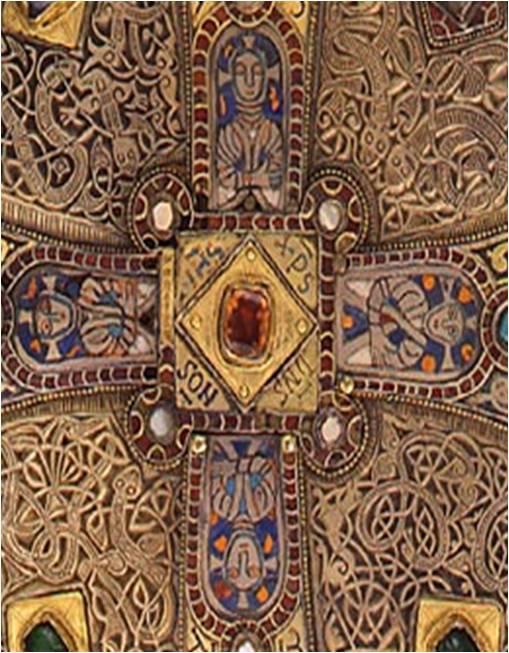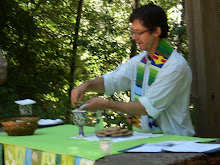One of the really strange things about this story I just
read is that it features such minor characters.
Mary Magdalene and Joanna merit exactly one prior mention in Luke’s
Gospel, back in Chapter 8, where there are a couple of verses about some women
whom Jesus cured of diseases, or cleansed of evil spirits, who went around with
him in Galilee and supported his mission out of their own means. Mary
the mother of James appears in this story here, for the first and only
time. And the men, the male disciples
who have been Jesus’ chief companions, witnesses to his adventures, and foils
for his teaching, are nowhere to be seen.
Which, of course, is how they wanted to be. When the chief priests and elders and temple
police came to arrest Jesus, led to him by one of the twelve, the other eleven scattered
and melted away into the night. Except
for Peter. Peter tailed them furtively all
the way to the high priest’s house, and even went after them into the courtyard,
and sat down with them around the bonfire.
But when a servant girl recognized him as a friend of Jesus, he denied
it three times. This story epitomizes
the danger that the disciples were in, in the aftermath of Jesus arrest and
trial and crucifixion. They didn’t know
whether the authorities would be hunting down his known associates and get rid
of them, too. So Peter and the other
disciples go underground.
But it is different for the women. The powers-that-be in Jerusalem would not have
seen them as leaders who might take Jesus’ place at the head of his movement,
or as teachers who would continue to spread his blasphemies. They would have considered such activities to
be the work of men. So the women are
left in relative peace to do the work that women do: of grieving; of caring for
bodies, the living bodies of children, brothers, and husbands, of elders, and
the bodies of the dead. The people who
killed Jesus wouldn’t give a second thought to some women going to his tomb. Their concern is with maintaining their rule
over the living, and Jesus doesn’t pose a threat to that anymore.
So the women come to mourn, to take
their final leave of Jesus, so that they can begin to move on. But his body, that was to be the tangible presence
of irretrievable loss, is gone. Only the
linen wrappings that shrouded the corpse remain, lying where he left them when
he walked out of the tomb. And the women
see a heavenly visitation that lights up as clear as the dawn what Jesus had
been trying to tell them all along. They
understood how he could only have accomplished what he had come to do by giving
himself over to the servants of death, and so to rise in the fullness of life
in the Spirit of God. And these
unimportant characters, who came from the margins of the story to pour out
their grief on the stark proof of death’s irresistible power, go away from the
tomb as the first of all, to bring news to the universe of the final victory of
life, of love, of joy.
But first they have to go and tell the guys. And no doubt they find the male disciples wrestling
with urgent questions: Is it safe to go out into the city, or are we wanted men? We could try to slip secretly out of town by
night and go back to Galilee, but news about what happened here will get there
before we do, and what kind of fools will we be, slinking home with our tails
between our legs? What was Jesus thinking,
bringing us here, and what did we think was going to happen? And what about the things we saw when we were
with him, the things we did, and heard, and thought we understood—it all seemed
so true, so powerful and real, but what are we to make of it now? Should we even stay together, even try to
carry on, and if so, who will lead us?
Who decides what we will do, and where we will go, now that Jesus is
gone?
So while these important debates are underway the women burst
in. Breathless from running, faces
strangely aglow, scarcely able to get the words out in their eagerness and
excitement, babbling about an empty tomb, about men in dazzling raiment who
asked them why they looked for the living among the dead. “And don’t you remember,” the women ask, “how
he told us back in Galilee, that he would be handed over to sinners, and die on
a cross, and on the third day rise again?
Now it has happened, just as he said!” You can imagine the awkward silence, as the
guys look around from one to another, and then finally one of them clears his throat,
and starts to speak: “So—like I was saying…”
At first the male disciples of Jesus
took the resurrection story as the hysterical chatter of some grief-crazed
women. But then they began to see the
signs of the risen Christ for themselves.
It wasn’t always easy for them to recognize him. And that’s still the way it is, for us. We still tend to think that the power of
resurrection depends on what can be believed about what did or didn’t “really
happen” to the body of Jesus in the darkness of the tomb. And more and more, people don’t even
care. To them it is an idle tale, a quaint,
outmoded superstition, a distraction from the important discussions about
saving for retirement, or how to crush ISIS, or keeping the kids off drugs.
But the approach to the resurrection
that I try to take is to follow the lead of the messengers who spoke to the women
at the tomb, when they reminded them of what Jesus was talking about all
along. Because all along Jesus talked
about people who prefer for their god a hard taskmaster only they can please; a
god of stern judgment, whose favor we can earn by working hard and following
the rules. We spawn a thousand myths to
deceive ourselves about this god, not all of them what we would necessarily
call “religious.” But all these myths are
self-serving, all view some other human beings as rivals and threats to what’s rightfully
mine. All justify coercion and violence
in the name of keeping order, and exclusion in the name of keeping our selves
pure. All these myths demand sacrificial
victims, and Jesus knew his enemies would make him one of these.
But he was also talking all along about
a God whom he called “Daddy,” a God of unconditional grace and love; of boundless
compassion and healing forgiveness, who continually makes the world anew. Jesus talked about a God whose first and
final word is “yes”, “yes” to the whole creation and to the goodness of life, who
is effervescently present and active everywhere, like a mustard seed or yeasty
dough, as abundant as a great catch of fish or a ripening field of grain, as simple
and playful and open-hearted as a little child.
And Jesus taught that this God sent him
to laugh at the gods of death, and to show the world how they are overcome. Which all sounds great in theory, but the
worldview of resurrection is hardly second nature to us. It has practical implications that cut deep across
the grain, such as “love your enemies, do good to those who hate you, and bless
those who curse you.” Which is why we
have places like this one here: places to come back week by week to listen
again to the words and deeds of the one who had the mind of resurrection all
along; places where we help one another to slip free of the snares of the idols
of death, and discover again that the empty tomb is not an idle tale; places where
we learn to see the signs of the risen life of Christ, as he left them for us—new
birth in a bath of water, and a wedding feast of bread and wine—so that, little
by little, we will come to see them everywhere.





